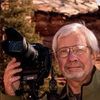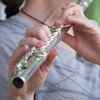Is there a time when aperture-priority is the optimum exposure mode?
Mar 24, 2017 15:56:23 #
buddingfatographer wrote:
...you guys are putting John on the cross ...!
UHH members are putting john on the cross because he claims aperture priority
only deserves a paragraph in an instruction book for photographers.
Instruction books need well explained facts, not personal opinions.
Mar 24, 2017 16:00:44 #
John Gerlach wrote:
What I said in the book years ago is likely true. ... (show quote)
I'm lost. What has light in the viewfinder and the problems it caused you to do with using aperture-priority exposure? And how does manual exposure then solve your problem by preventing light from entering the viewfinder?
Mar 24, 2017 16:13:13 #
John Gerlach wrote:
Hi Hogs, br br I am about to begin the second rev... (show quote)
Photography has been my hobby since 1953. I've shot a variety of film and digital formats. In the last few years, I've been doing more HDR work with landscape photography. I simply cannot imagine doing 3-9 exposures at changing apertures for HDR work. If you have done so, I'd like to know how you did it. For me, to be successful, I have found that for such work it means either doing varying shutter speeds or varying ISO.
Mar 24, 2017 16:13:52 #
buddingfatographer
Loc: Nashville
oldtigger wrote:
UHH members are putting john on the cross because he claims aperture priority
only deserves a paragraph in an instruction book for photographers.
Instruction books need well explained facts, not personal opinions.
only deserves a paragraph in an instruction book for photographers.
Instruction books need well explained facts, not personal opinions.
Don't buy his book... buy a book that focuses on aperture priority... problem solved. If you want Johns book with more about aperture priority... START GIVING OPINIONS ON APERTURE PRIORITY! Not try to figure out if, or why he doesn't use it! You guys are regular detectives, let me tell ya! You've singlehandedly cracked the case... ole John faking an AP malfunction. You caught him. Well done men... case closed!
Mar 24, 2017 16:19:31 #
John Gerlach wrote:
I agree that aperture is often critical. So how does manual exposure not give you the same control? Just set the aperture you want, and adjust the exposure with the shutter, or even the ISO. One advantage of manual is you have shutter, aperture, and ISO available to adjust the exposure.
Although Kymarto has posted in the thread already, I think his post in the thread "Full Manual Mode" is even more succinct. Kymarto is an active professional photographer and his opinions carry extra weight with me, as I think they do with others:
"Personally I don't see the point of doing more work than necessary. I shoot with scores of vintage lenses in aperture priority mode. I let the camera decide the shutter speed--it gets me in the ballpark quick and easy, and I adjust using exposure compensation if necessary. Once I have that set up for a given scene, there is never a question of having to reset stuff if the light changes, for instance. As a pro, what counts for me is to get the shot, period. Manual is simply slower than letting the technology do what it is designed to do.
If you really want to go old school, then learn the sunny sixteen rule and don't use a meter at all. If you use a meter anyway, why not let the camera set the exposure--saves time. Then there is the AE lock button if you want to keep the exposure and move the camera. I can think of no good productive reason to use manual mode anymore."
Mar 24, 2017 16:26:49 #
buddingfatographer
Loc: Nashville
I had a boss once, whom I refused to call a boss because he was a fantastic leader and the smartest man I've ever met... regarding what we did or otherwise. He had been doing what we did longer than I had been alive, but never hesitated or felt embarrassed by asking me a question or what I thought about a situation, maybe a better way. Any of his crew. It didn't mean that he would do it my way... but he never felt any ego deficiency asking and I admired him greatly for that. Someone who I thought knew it all (and probably did) asking me my opinion? The thought of criticising him for that makes my skin crawl, and anyone who has served under a true leader will understand what that means. Knocking a guy for asking is the reason there are so many lost men driving around, asking for directions once in awhile or the inability to do so... is the difference in being on time or looking like an absolute jack ***.
Mar 24, 2017 16:28:32 #
buddingfatographer wrote:
So what's the big conspiracy here? Are you insinua... (show quote)
Maybe the forum needs to change its name to Grumpy Old Men! Never seen such vitriol over a simple, sincerely asked question. Jeez!
And then the rationalizations to justify the lack of bothering to read in context. Does no one have any civility on this board any longer? I'm starting to think this board would tell Ansel Adams that his sky on "Moon over Hernandez" was over processed and over exposed and invalidate it because it wasn't printed SOOC, LOL!
I wonder if he would have ever devised the Zone System if he had aperture priority available? Besides, what did he know after a lifetime of shooting?
Mar 24, 2017 16:34:28 #
It isn't an issue. Once I manually determine the exposure I want by looking at the highlight alert now more than the histogram, I don't have to be concerned about light entering the viewfinder. While the exposure meter indicator might move, in manual exposure the camera exposure settings remain the same unless I turn the ISO, aperture, or shutter. The camera doesn't automatically do it, but don't use auto ISO here with manual. In other words, light entering the viewfinder can't change things on you when everything is in manual.
cfbudd wrote:
I'm lost. What has light in the viewfinder and the problems it caused you to do with using aperture-priority exposure? And how does manual exposure then solve your problem by preventing light from entering the viewfinder?
Mar 24, 2017 16:39:49 #
Peterff wrote:
The important point is that you are thinking about the result and your instrument. You play in sessions, which are very dynamic situations.
...
...
Thanks!
Mar 24, 2017 16:47:19 #
How about this one. You are photographing a hummingbird in dim light with 4 flashes set to 1/32 power. You want to freeze the motion of the bird. Do you think this will work with any auto mode? It won't because then the camera will try to expose with ambient light by slowing the shutter down in aperture-priority. Best to use manual exposure and perhaps set sync speed and f/16 to exclude the ambient. And that is what I have (usually ) against aperture-priority. In almost every situation, I see the pitfalls with it and know a faster and more precise way to get the exposure I seek. I don't find manual to be more work, but rather less work!
SteveR wrote:
Although Kymarto has posted in the thread already,... (show quote)
Mar 24, 2017 16:52:42 #
Don't get me started on the sunny 16 rule. I used to call it the "when to quit rule." It worked in bright sun conditions that I typically avoided with slide film at the time. Bright sun isn't so bad now that we can adjust color temp and contrast with software. Now we can shoot longer on Kenya safaris and still get pleasing images. The sun jumps up there pretty fast around the equator.
SteveR wrote:
Although Kymarto has posted in the thread already,... (show quote)
Mar 24, 2017 16:56:26 #
buddingfatographer
Loc: Nashville
Here's a quote for you... "We use a "don't cut any corners" shooting work flow that WE AND OUR SMART CLIENTS have DEVELOPED TOGETHER over the years that anyone can learn to use." (Taken from John's own site) I guess John listens to others (even clients or students) when it comes to technique or options in taking a photograph.
Mar 24, 2017 16:57:15 #
You have got to be kidding me; you are writing a book on landscape photography and have to ask this question? Whenever depth of field is a priority and you want to control it. You may want to research tripods on this forum as they are useful when the photographer wants to use a low ISO (to minimize noise) and the resultant shutter speed doesn't permit hand holding (often). That should be good for a chapter!
Mar 24, 2017 17:09:28 #
John Gerlach wrote:
... the camera will try to expose with ambient light by slowing the shutter down in aperture-priority. ...
When using flash fill inside with dim subjects and backlit widows, i set the flash level,
select auto aperture and never have to worry about the windows blowing out.
Mar 24, 2017 17:12:20 #
I prefer aperture priority as my "default" setting. When on the move, in a travel mode, or anywhere, your camera is already ready to take the shot. I leave it on f/8 for a better depth of field, and on ISO 200. With experience, you will know when it is time to raise the ISO. But again, the main reason is that when you see a potentially good shot, you want to be as ready as possible to take it. Now, a lot of what I do is not as rushed, but I still find the settings I mention to be my "default" for best results. Hope this is helpful. Jim R
If you want to reply, then register here. Registration is free and your account is created instantly, so you can post right away.








